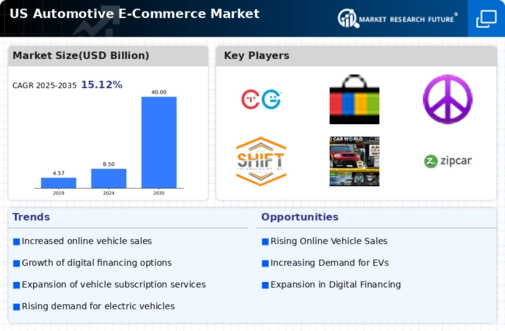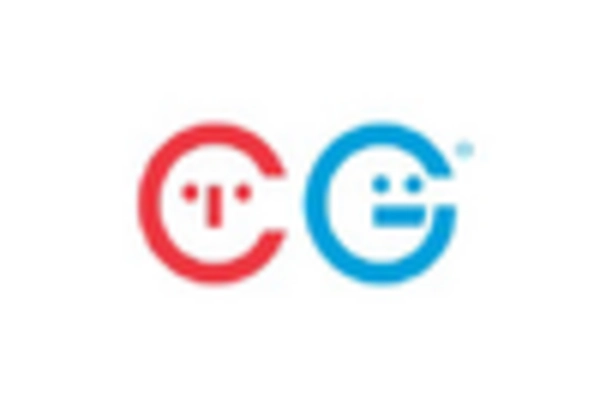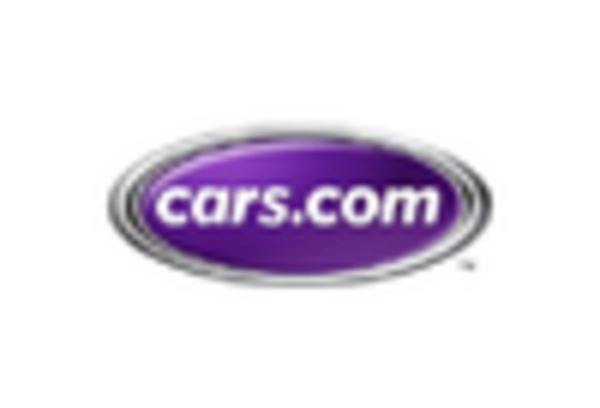Enhanced Vehicle Customization Options
The automotive ecommerce market is benefiting from enhanced vehicle customization options, which are becoming a key driver of consumer engagement. In 2025, approximately 35% of online vehicle buyers express a desire for personalized features, such as color, interior design, and technology packages. This trend reflects a shift towards individualized consumer experiences, where buyers seek to tailor their vehicles to match their preferences. The automotive ecommerce market is responding by offering advanced configurators that allow consumers to visualize their customizations in real-time. This interactive approach not only enhances customer satisfaction but also increases the likelihood of purchase. Additionally, the ability to compare different configurations online empowers consumers to make informed decisions. As customization becomes more prevalent, the automotive ecommerce market is expected to thrive, as it aligns with the growing demand for unique and personalized products.
Expansion of Digital Payment Solutions
The automotive ecommerce market is witnessing a rapid expansion of digital payment solutions, which is reshaping the purchasing landscape. In 2025, nearly 45% of online vehicle transactions are expected to utilize digital payment methods, reflecting a growing trust in online financial transactions. This shift is driven by advancements in technology, including secure payment gateways and mobile wallets, which enhance the safety and efficiency of online purchases. The automotive ecommerce market is capitalizing on this trend by partnering with fintech companies to offer seamless payment options. Additionally, the rise of buy-now-pay-later services is making vehicle purchases more accessible to a broader audience. As consumers become more comfortable with digital transactions, the automotive ecommerce market is likely to see an increase in sales volume, as financial barriers are lowered and purchasing becomes more straightforward.
Increased Consumer Demand for Convenience
The automotive ecommerce market is experiencing a notable surge in consumer demand for convenience. As consumers increasingly prioritize time-saving solutions, the ability to purchase vehicles online has become a significant driver. In 2025, approximately 60% of consumers express a preference for online vehicle shopping due to its ease and accessibility. This trend indicates a shift in consumer behavior, where traditional dealership visits are being replaced by online platforms. The automotive ecommerce market is adapting to this demand by enhancing user experiences, offering virtual showrooms, and streamlining the purchasing process. Furthermore, the integration of mobile applications allows consumers to browse and buy vehicles from their smartphones, further solidifying the convenience factor. As this trend continues, it is likely that more businesses will invest in digital platforms to cater to the evolving preferences of consumers.
Growing Interest in Electric Vehicles (EVs)
The automotive ecommerce market is increasingly influenced by the growing interest in electric vehicles (EVs). As environmental concerns gain traction, consumers are actively seeking sustainable transportation options. In 2025, EV sales are projected to account for approximately 25% of total vehicle sales in the ecommerce sector. This shift is prompting online retailers to expand their offerings to include a wider range of EV models, thereby catering to the evolving preferences of environmentally conscious consumers. The automotive ecommerce market is responding by providing detailed information on EV specifications, charging infrastructure, and incentives available for buyers. Furthermore, the integration of virtual reality tools allows potential buyers to explore EV features interactively. As the demand for EVs continues to rise, the automotive ecommerce market is likely to experience significant growth, driven by the increasing availability and consumer interest in electric mobility.
Rise of Social Media Influence on Purchases
The automotive ecommerce market is increasingly shaped by the rise of social media influence on consumer purchasing decisions. In 2025, studies indicate that nearly 50% of potential vehicle buyers utilize social media platforms for research and recommendations before making a purchase. This trend highlights the importance of online presence and engagement for automotive retailers. The automotive ecommerce market is adapting by leveraging social media marketing strategies to reach and engage consumers effectively. Influencer partnerships and targeted advertising campaigns are becoming common practices to enhance brand visibility and credibility. Furthermore, user-generated content, such as reviews and testimonials, plays a crucial role in shaping consumer perceptions. As social media continues to evolve, its impact on the automotive ecommerce market is likely to grow, driving sales and fostering brand loyalty among consumers.

















Leave a Comment